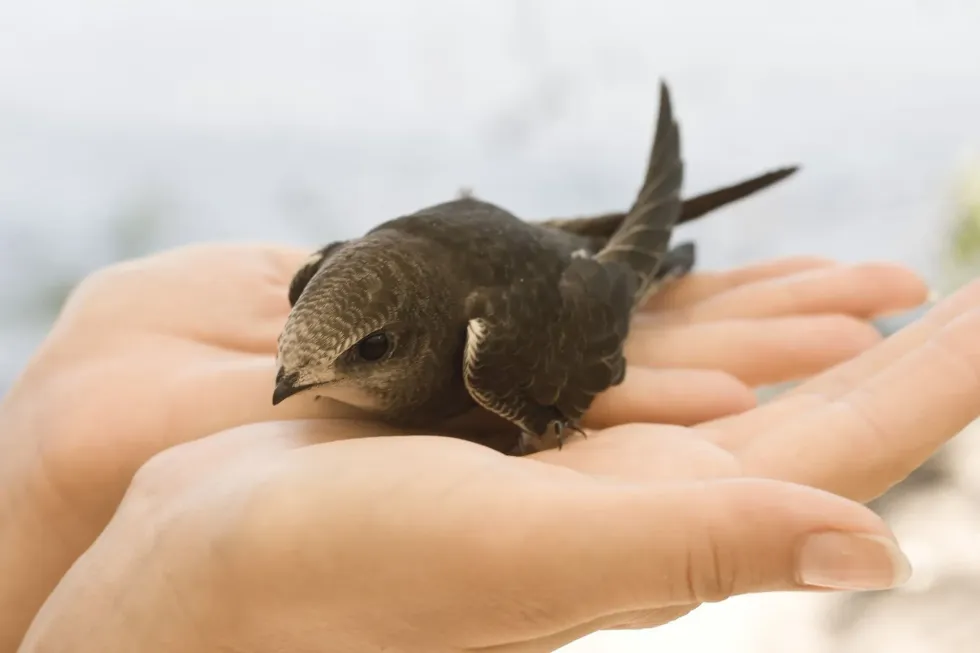Black Swift, Cypseloides niger is a bird species that belongs to the family of Apodidae. These birds build their nests and breed in the crevices of the mountains, near or behind waterfalls.
Migration is observed among these Black Swift Alabama birds. They are the resident of western North America, especially Southwest Canada during summer days.
The species flocks towards South America, along the coast of the U.S., as far as the rainforests in Brazil and Colorado during the winter months. During the breeding season, the nesting site is usually near a water source.
The family size of these birds is small as the parents usually lay only one egg in the nest during each breeding season.
They have black or dark grey feathers and a slightly bent small beak. The wing is curved around the edge.
The bird flies at a speed of 69 mph (111 kph) in the air. They feed on different flying insects like flying ants and beetles.
Foraging also takes place in the open air during flights. These birds have been listed as vulnerable by the IUCN Red List. Not much is known about these birds since the nests are built in inaccessible areas.
A large part of their range of non-breeding habitats, winter migration, family structure, the distribution of their species, and description of aerial interactions remain a mystery. Thus conservation efforts are being made to safeguard the Black Swifts from going towards extinction.
If you like reading this article, then check out these other articles on Ovenbird facts and Swallow-Tailed Kite facts.
Black Swift Interesting Facts
What type of animal is a Black Swift?
Black Swift is a kind of bird.
What class of animal does a Black Swift belong to?
Black Swift, Cypseloides niger, belongs to the class of Aves like the common Swift
How many Black Swifts are there in the world?
There are approximately 210,000 of the Black Swift population left in the world.
Where does a Black Swift live?
Black Swifts are found in the western part of Canada called the British Province. They also live in countries from North America like United States, Costa Rico, Colorado, Mexico, Brazil, and the Caribbean Islands. These birds spend the winter in the South of the Sahara. They have been spotted in Malawi, Mozambique, Tanzania, Zimbabwe, Congo Basin, and South Africa.
What is a Black Swift's habitat?
Black Swifts have a varied range of habitats. Historically speaking, these birds built their nest in holes of tall trees, much above the ground.
Some of these birds still build their nests in Scot Pines in the forests of Scottland. They also need a specialized habitat for nesting. They are found in coastal cliffs, especially the crevices in the cliffs which are near to the coast or the waterfalls originating from the mountain.
Who do Black Swifts live with?
Black Swifts are social birds and they live and roost in large groups. Most of these North American birds are colonial breeders which means they build their nests in colonies. However, some of these birds are solitary.
How long does a Black Swift live?
The Black Swift bird's lifespan is about about 10 years.
How do they reproduce?
Black Swifts are monogamous and the breeding ritual involves courtship where there is an ariel chase involved. Black Swift species live in the sky and they even mate in the air while flying.
These birds nest in small colonies in the crevices of the mountain, on cliffs, and behind waterfalls. The nest is built with mud and moss. The clutch size is generally of one egg.
Often the breeding pairs reuse the nest for successive breeding seasons. The nesting period lasts for around 45-50 days while the incubation period is 23-30 days. The egg is white in color and is around 0.9-1.3 in (2.2-3.3 cm) in length and 0.7-0.8 in (1.7-2.03 cm) in breadth.
The chicks are born with closed eyes and both parents take a turn in feeding the young one. The young ones take their first flight when they are 45-49 days old.
What is their conservation status?
Black Swift is given the vulnerable status by the IUCN Red List. The distribution of these birds has been rapidly decreasing over the years.
The reason behind it is not fully known. However, it is believed that climate change can be one of the key reasons.
The primary diet of these birds are insects, which also makes them vulnerable to different kinds of pesticides. These birds are protected by the Migratory Bird Act, the U.S.
There has been a 94% decline in the Black Swift population from 1970 - 2014. These North American birds have a continental concern score of 15 out of 20 on a scale where 20 is for the most level of concern.
It has been estimated that these birds will lose another half of their entire population by the year 2033.
These birds are protected by the Migratory Birds Convention Act in Canada. Several precautions have been taken to safeguard the declining population of this bird species over the years.
Researches are being done to understand the habitat range of these mysterious birds like the rocky and mountainous areas, often behind waterfalls. Efforts have also been made in limiting the usage of insecticides around the range map of its living zone.
Black Swift Fun Facts
What do Black Swifts look like?

Swifts are predominantly black in color with occasional white spots on the sides. They may have dark grey feathers. These birds have forked tails. The body is streamlined, which makes them excellent flyers and their wings are narrow.
The shoulders have darker feathers than the wings. The wings are curved to make them faster at flying. Juveniles have whitish underbelly. They also have slightly bent small beaks.
How cute are they?
They are cute to look at. Their forked tail, curved wing, and jet black streamlined body make them look adorable.
How do they communicate?
Black Swift communicates with each other in several different ways. Firstly, they make aerial interactions, while flying, which can be short and swift in nature. When there is a predator around, these birds raise their wings upwards for intimidation.
This type of communication is called the hostile display. The young ones also showcase food begging behavior in which the chicks make low-intensity sounds to get their parents' attention. Black Swift bird call also includes several tweeting sounds.
How big is a Black Swift?
Black Swifts are around 6.3–7.1 in (16–18 cm) in length.
How fast can a Black Swift fly?
The Black Swift bird lives in the sky and their streamline body along with curved long wings and forked tail makes them one of the best flight birds. These birds fly at a speed of 69 mph (111 kph).
For the longest time, this bird species was known to fly with the maximum speed. Now it is second to the Brazillian free-tailed bat.
How much does a Black Swift weigh?
The Black Swift weighs around 1.6 oz (45.3 g).
What are the male and female names of the species?
No specific names have been given to the male and female birds of the species.
What would you call a baby Black Swift?
A baby Black Swift is called a chick.
What do they eat?
Black Swifts are insectivorous. They forage in the open air and feed on different types of insects like flying ants, beetles. The adult birds feed the nestlings a sticky mess of saliva and the flying insects.
Are they poisonous?
The species of Black Swift is not known to be poisonous.
Would they make a good pet?
It is illegal to keep these birds as pets in most places. Black Swift is given the vulnerable bird species by the IUCN Red List with its folks rapidly decreasing due to several factors.
Moreover, these mysterious bird species are migratory in nature, as they move to South America from North America during winter, which makes it quite difficult to keep them as pets. They also forage in the open air which makes it hard to keep them locked in cages.
Did you know...
Black Swifts spend a lot of their time in the sky. They are also known to forage during flights, in the air. The foraging grounds are mainly large open areas like meadows and grasslands.
Black Swifts belong to the family of Apodidae and they range in several countries in North America
Do Black Swifts migrate?
Black Swifts are migratory birds. In summer and spring, they are the resident in Southwest Canada.
The bird species flocks to South America in the fall. They spend most of their non-breeding season in areas that range from the rainforests of Brazil to Colorado for around 220 days and flies for around 224 mi (360.4 km) during the Spring migration.
Are Black Swifts endangered?
The Black Swift species has been listed as vulnerable by the IUCN Red List.
Only 210,000 of these birds are left in this world and their number is falling rapidly.
Not much is known about these birds and a large part of it remains a mystery. As these birds make their nests in inaccessible areas that range from mountains and cliffs, behind waterfalls, it makes them a very difficult species to know about.
However, conservation efforts have been made to study their nesting behavior, their interactive range map, foraging behavior, migratory pattern, from North American countries to South America during winter, their diet which includes the kind of flying insects they feed on, and whether they are subjected to pesticides.
Here at Kidadl, we have carefully created lots of interesting family-friendly animal facts for everyone to discover! For more relatable content, check out these Swallow facts and Arctic Tern facts for kids.
You can even occupy yourself at home by coloring in one of our free printable bird coloring pages.









